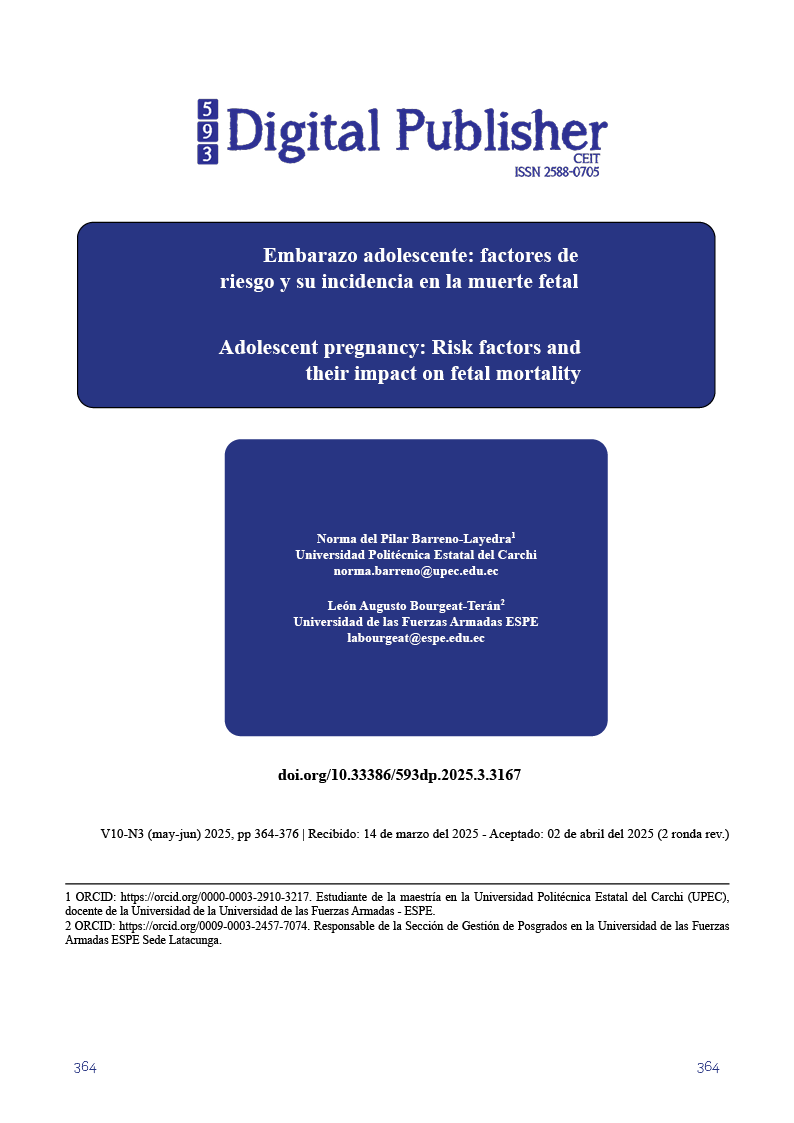Adolescent pregnancy: Risk factors and their impact on fetal mortality
Main Article Content
Abstract
This quantitative, observational, and retrospective study analyzes the risk factors associated with fetal mortality among adolescent mothers in Ecuador. Secondary data from the National Institute of Statistics and Censuses (INEC, 2022) were used, and binary logistic regression techniques were applied, along with machine learning models such as XGBoost and LightGBM, to develop high-accuracy predictive models.
The results indicate that gestational age is the main protective factor: each additional week reduces the probability of fetal death by 8.5% (OR = 0.915, 95% CI: 0.887–0.943, p < 0.001). Furthermore, a higher risk of fetal mortality was identified in mothers with fewer than five prenatal check-ups (OR = 3.24, 95% CI: 2.17–4.83) and in births that occurred outside the hospital setting (OR = 2.71, 95% CI: 1.88–3.91).
The predictive models showed high performance, with XGBoost being the most accurate (AUC = 1.000), followed by LightGBM (AUC = 0.9997). These findings highlight the need to strengthen prenatal care, improve hospital infrastructure, and use artificial intelligence tools for early detection of high-risk pregnancies in vulnerable populations.
Downloads
Article Details

This work is licensed under a Creative Commons Attribution-NonCommercial-ShareAlike 4.0 International License.
1. Derechos de autor
Las obras que se publican en 593 Digital Publisher CEIT están sujetas a los siguientes términos:
1.1. 593 Digital Publisher CEIT, conserva los derechos patrimoniales (copyright) de las obras publicadas, favorece y permite la reutilización de las mismas bajo la licencia Licencia Creative Commons 4.0 de Reconocimiento-NoComercial-CompartirIgual 4.0, por lo cual se pueden copiar, usar, difundir, transmitir y exponer públicamente, siempre que:
1.1.a. Se cite la autoría y fuente original de su publicación (revista, editorial, URL).
1.1.b. No se usen para fines comerciales u onerosos.
1.1.c. Se mencione la existencia y especificaciones de esta licencia de uso.
References
Almache, G., Joel, C., & Isabel, E. (2025). Impact of the prenatal period and maternal role in university academic development : bibliographic review Repercusión del período prenatal y rol materno en el desarrollo académico universitario : revisión bibliográfica Resumen. 9(1), 1–27.
Berlanga-silvente, V. (2014). Cómo obtener un Modelo de Regresión Logística Binaria con SPSS. REIRE. Revista d’Innovació i Recerca En Educació, 7(8(2)), 105–118. https://doi.org/10.1344/reire2014.7.2727
Bezerra, I. M. P., Ramos, J. L. S., Pianissola, M. C., Adami, F., da Rocha, J. B. F., Ribeiro, M. A. L., de Castro, M. R., Bezerra, J. da F., Smiderle, F. R. N., Sousa, L. V. de A., Siqueira, C. E., & de Abreu, L. C. (2021). Perinatal mortality analysis in espírito santo, brazil, 2008 to 2017. International Journal of Environmental Research and Public Health, 18(21). https://doi.org/10.3390/ijerph182111671
Bhutta, Z. A., Ahmed, T., Black, R. E., Cousens, S., Dewey, K., Giugliani, E., Haider, B. A., Kirkwood, B., Morris, S. S., Sachdev, H., & Shekar, M. (2008). What works? Interventions for maternal and child undernutrition and survival. The Lancet, 371(9610), 417–440. https://doi.org/10.1016/S0140-6736(07)61693-6
Blencowe, H., Krasevec, J., de Onis, M., Black, R. E., An, X., Stevens, G. A., Borghi, E., Hayashi, C., Estevez, D., Cegolon, L., Shiekh, S., Ponce Hardy, V., Lawn, J. E., & Cousens, S. (2019). National, regional, and worldwide estimates of low birthweight in 2015, with trends from 2000: a systematic analysis. The Lancet Global Health, 7(7), e849–e860. https://doi.org/10.1016/S2214-109X(18)30565-5
Breiman, L. (2001). Random Forests. 45, 5–32.
Chen, T., & Guestrin, C. (2016). XGBoost: A scalable tree boosting system. Proceedings of the ACM SIGKDD International Conference on Knowledge Discovery and Data Mining, 13-17-Augu, 785–794. https://doi.org/10.1145/2939672.2939785
Dowswell, T., Carroli, G., Duley, L., Gates, S., Gülmezoglu, A. M., Khan-Neelofur, D., & Piaggio, G. (2015). Alternative versus standard packages of antenatal care for low-risk pregnancy. Cochrane Database of Systematic Reviews, 2015(7). https://doi.org/10.1002/14651858.CD000934.pub3
Fawcett, T. (2006). An introduction to ROC analysis. Pattern Recognition Letters, 27(8), 861–874. https://doi.org/10.1016/j.patrec.2005.10.010
Galeano, D. O., Orozco, F. A., & Urquia, M. L. (2023). Child marriage and perinatal health in Ecuador, 2015-2020; [Casamiento infantil y salud perinatal en Ecuador, 2015-2020]. Salud Colectiva, 19. https://doi.org/10.18294/SC.2023.4325
INEC. (2022). Ecuador - Estadística de Defunciones Fetales 2022 Información general. 3–9.
Instituto Nacional de Salud, & Ministerio de Salud. (2020). Mortalidad Perinatal y Neonatal Tardía, Colombia, 2020. Informe De Evento, 1–23. https://www.ins.gov.co/buscador-eventos/Informesdeevento/MORTALIDAD PERINATAL Y NEONATAL TARDÍA_2020.pdf
Mezmur, H., Assefa, N., & Alemayehu, T. (2021). An Increased Adverse Fetal Outcome Has Been Observed among Teen Pregnant Women in Rural Eastern Ethiopia: A Comparative Cross-Sectional Study. Global Pediatric Health, 8. https://doi.org/10.1177/2333794X21999154
Mohamed, S. M., Abonazel, M. R., & Ghallab, M. G. (2023). Performance Evaluation of Imputation Methods for Missing Data in Logistic Regression Model: Simulation and Application. Thailand Statistician, 21(4), 926–942.
Nuwabaine, L., Sserwanja, Q., Kamara, K., & Musaba, M. W. (2023). Prevalence and factors associated with teenage pregnancy in Sierra Leone: evidence from a nationally representative Demographic and Health Survey of 2019. BMC Public Health, 23(1), 1–8. https://doi.org/10.1186/s12889-023-15436-x
OMS. (2022). Embarazo en la adolescencia. Organización Mundial de La Salud. https://www.who.int/es/news-room/fact-sheets/detail/adolescent-pregnancy#
Ortiz, R. A., Otalora, M. F., Muriel, A. B., & Luna, D. A. (2018). Adolescencia como factor de riesgo para complicaciones maternas y neonatales. Revista Chilena de Obstetricia y Ginecologia, 83(5), 478–486. https:/www.scielo.cl/scielo.php?script=sci_arttext&pid=S0717-75262018000500478
Pupo Jimenez, J. M., Gonzáles Aguilar, J. C., Cabrera Lavernia, J. O., & Cedaño Tarncón, O. (2019). Factores de riesgo de morbilidad materna extrema en la unidad de cuidados intensivos. Multimed, 23(2), 280–296. https://doi.org/10.25100/cm.v50i4.4197
Rajkomar, A., Dean, J., & Kohane, I. (2019). Machine Learning in Medicine. New England Journal of Medicine, 380(14), 1347–1358. https://doi.org/10.1056/nejmra1814259
Ruth, D., Rengel, E. M., Suarez, R., Ana, D., Rojas Rodríguez, L., Yadira, D., Cueva, G., Elizabeth, R., & Rengel, M. (2020). Una mirada distinta al embarazo adolescente tfm. Recimundo.Com, 228–235. https://doi.org/10.26820/recimundo/4.(4).noviembre.2020.228-235
Wickham, M. H., Chang, W., & Wickham, M. H. (2016). Package “ggplot2”. Create elegant data visualizations using the grammer of graphics. Version, 2(1), 1–89.



